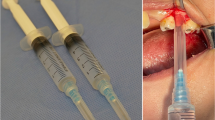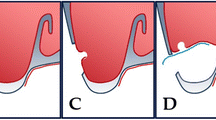Abstract
Introduction
Sinus Augmentation has proven to be a predictable and popular approach to overcome bone volume deficiency in the posterior maxilla for patients seeking dental implants. The most common surgical methods utilized for maxillary sinus augmentations are the lateral window approach and crestal osteotome technique, which may cause many complications like sinus membrane tear, bleeding, sinusitis, etc. the purpose of this study is to compare complications rates of different sinus lift techniques in dental implant surgery.
Aims and Objective
To assess the intraoperative and postoperative complications between the conventional direct or indirect method with alternative sinus lift techniques using Modified Crestal and Lateral (CAS & LAS KIT) ®method (Osstem/Hiossen).
Materials and Methods
This is a retrospective study where in all the sinus lift cases done during 3year duration in the center data was collected and analyzed a total of 61 sinus lift procedure was done and all the data is tabulated and analyzed.
Results
Results show of the total 61 cases 25 (40%) male patients and 36(59%)female patients traditional techniques like summers osteotome and conventional direct or indirect method had 7 cases (33.3%-37.5%) complication rates compared to Modified Lateral osteotome had 2 complications (14.2%) & Modified Crestal osteotome had only 3 case(3.7%) infections, wound dehiscence, membrane tear etc
Conclusion
Modified Crestal & Lateral Osteotome (CAS KIT & LAS KIT) ® technique does reduce the incidence of complications like sinus membrane tear compared to conventional Direct and Indirect techniques, because of stopper system used in hydraulic lift and the special design of drill head of these instruments.




Similar content being viewed by others
References
Jensen OT, Shulman LB, Block MS et al (1998) Report of the sinus consensus conference of 1996. Int J Oral Maxillofac Implants 13(Suppl):11–45
Carreno JC et al (2016) Update of surgical techniques for maxillary sinus augmentation: a systemic literature review. Implant Dentistry. 25(6):839–844
Fugazzotto P, Melnick PR, Al-Sabbagh M (2015) Complications when augmenting the posterior maxilla. Dental Clinics of North America 59(1):97–130
Tatum OH (1977) Maxillary sinus grafting for endosseous implants. In: Pre- sented at the annual meeting of the alabama implant study group. Birmingham, AL.
Tatum OH (1986) Maxillary and sinus implant reconstructions. Dent Clin North Am 30:207–229
Nkenke E, Stelzle F (2009) Clinical outcomes of sinus floor augmentation for implant placement using autogenous bone or bone substitutes: A systematic review. Clin Oral Implants Res 20(suppl 4):124–133
Schwarz L et al (2015) Risk factors of membrane perforation and postoperative complications in sinus floor elevation surgery: review of 407 augmentation procedures. J Oral Maxillofac Surg. https://doi.org/10.1016/.01.039
Pjetursson BE, Tan WC, Zwahlen M, Lang NP (2008) A systematic review of the success of sinus floor elevation and survival of implants inserted in combination of sinus floor elevation. Part I: Lateral approach. J Clin Periodontol. 35(suppl 8):216–240
Tan WC, Lang NP, Zwahlen M, Pjetursson BE (2008) A systematic review of the success of sinus floor elevation and survival of implants in- serted in combination of sinus floor elevation. Part II: Transalveolar technique. J Clin Periodontol 35(suppl 8):241–254
Aghaloo TL, Moy PK (2007) Which hard tissue augmentation techniques are the most successful in furnishing bony support for implant placement? Int J Oral Maxillofac Implants 22(suppl):49–70
Al-Moraissi EA et al (2019) What is the most effective rehabilitation method for posterior maxillae with 4 to 8 mm of residual alveolar bone height below the maxillary sinus with implant-supported prostheses A frequentist network meta-analysis. J Oral Maxillofacial Surg. 77(1):70.e1-70.e33
Pal US, Sharma NK, Singh RK, Mahammad S, Mehrotra D, Singh N, Mandhyan D (2012) Direct vs. indirect sinus lift procedure: A comparison. Natl J Maxillofac Surg. 3:31–7
Stern A, Green J (2012) Sinus lift procedures: an overview of current techniques. Dent Clin North Am 56(1):219–233
Wallace SS, Mazor Z, Froum SJ, Cho SC, Tarnow DP (2007) Schneiderian membrane perforation rate during sinus elevation using piezosur- gery: Clinical results of 100 consecutive cases. Int J Periodontics Restorative Dent 27:413–419
Kim J, Jang H (2019) A review of complications of maxillary sinus augmentation and available treatment methods. J Korean Assoc Oral Maxillofac Surg. 45:220–224
Lum AG, Ogata Y, Pagni SE, Hur Y (2017) The association between sinus membrane thickness and membrane perforation in lateral window sinus augmentation: a retrospective study. J Periodontol 1902:160694
Toscano NJ, Holtzclaw D, Rosen PS (2010) The effect of piezoelectric use on open sinus lift perforation: A retrospective evaluation of 56 consecutively treated cases from private practices. J Periodontol 81:167–171
Jo KH, Yoon KH, Cheong JK, Jeon IS (2014) Postoperative perforation of the schneiderian membrane in maxillary sinus augmentation: a case report. J Oral Implantol 40:375–379
Fugazzotto et al (2015) Complications When Augmenting the Posterior Maxilla. DentClinNAm 59:97–130. https://doi.org/10.1016/j.cden.2014.09.005
Stern A, Green J (2012) Sinus lift procedures: an overview of current techniques. Dent Clin N Am 56:219–233
Weitz DS, Geminiani A, Papadimitriou DE et al (2014) The incidence of membrane perforation during sinus floor elevation using sonic instruments: a series of 40 cases. Int J Periodontics Restorative Dent 34(1):105–112
Tukel HC, Tatli U (2018) Risk factors and clinical outcomes of sinus membrane perforation during lateral window sinus lifting: analysis of 120 patients. Int J Oral Maxillofacial Surg
Moreno Vazquez JC, Gonzalez de Rivera AS, Gil HS, Mifsut RS (2014) Complication rate in 200 consecutive sinus lift procedures: guidelines for prevention and treatment. J Oral Maxillofac Surg 1–10.
Lee H-W, Lin W-S, Dean M (2013) A retrospective study of complications associated with 100 consecutive maxillary sinus augmentations via the lateral window approach. Int J Oral Maxillofacial Implants. 28(3):860–868
Yassin Alsabbagh A, Alsabbagh MM, Darjazini Nahas B et al (2017) Comparison of three different methods of internal sinus lifting for elevation heights of 7 mm: an ex vivo study. Int J Implant Dent, 3(40): 729–017–0103–5.
Bae OY, Kim YS, Shin SY, Kim WK, Lee YK, Kim SH (2015) Clinical outcomes of reamer- vs osteotome-mediated sinus floor elevation with simultaneous implant placement: a 2-year retrospective study. Int J Oral Maxillofac Implants 30(4):925–930
Ahn SH, Park EJ, Kim ES (2012) Reamer-mediated transalveolar sinus floor elevation without osteotome and simultaneous implant placement in the maxillary molar area: clinical outcomes of 391 implants in 380 patients. Clin Oral Implants Res 23(7):866–872
Misch CE (1999) The maxillary sinus lift and sinus graft surgery. In: Misch CE (ed) Contemporary implant dentistry. Mosby, Chicago, pp 469–495
Proussaefs P, Lozada JL (2003) The “Loma Linda pouch”: a technique for repairing the perforated sinus membrane. Int J Periodontics Restor-ative Dent 23:593–597
Testori T, Wallace SS, Del Fabbro M et al (2008) Repair of large sinus mem- brane perforations using stabilized collagen barrier membranes: Surgical techniques with histologic and radiographic evidence of success. Int J Periodontics Restorative Dent 28:9–17
Chen L, Cha J, Chen HC, Lin HL (2011) Sinus perforation: Treatment and classifications. J Implant Adv Clin Dent 3:19–30
Pikos MA (2008) Maxillary sinus membrane repair: Update on technique for large and complete perforations. Implant Dent 17:24–31
Hernandez-Alfaro F, Torradeflot MM, Marti C (2008) Prevalence and management of Schneiderian membrane perforations during sinus-lift procedures. Clin Oral Implants Res 19:91–98
Geminiani A et al (2017) A meta-analysis of complications during sinus augmentation procedure. Quintessence Int 48(3):231–240
Raghoebar GM, Batenburg RH, Timmenga NM et al (1999) Morbidity and complication of bone grafting of the floor of the maxillary sinus for placement of endosseous implants. Mund Kiefer Grsichtschir 3:65
Thomas Starch-Jensen, Janek Dalsgaard Jensen. Maxillary Sinus Floor Augmentation:A Review of Selected Treatment Modalities. J Oral Maxillofacial Res 2017; 8(3).
Author information
Authors and Affiliations
Corresponding author
Ethics declarations
Conflict of interest
The authors declare that they have no conflict of interest.
Additional information
Publisher's Note
Springer Nature remains neutral with regard to jurisdictional claims in published maps and institutional affiliations.
Rights and permissions
About this article
Cite this article
G.K, V., Reader, Ahmed, N. et al. Complications of Conventional Sinus Augmentation Techniques Versus Modified Osteotome Techniques in Dental Implant Surgery: A 3-Year Retrospective Clinical Study. J. Maxillofac. Oral Surg. 22, 287–295 (2023). https://doi.org/10.1007/s12663-022-01733-2
Received:
Accepted:
Published:
Issue Date:
DOI: https://doi.org/10.1007/s12663-022-01733-2




